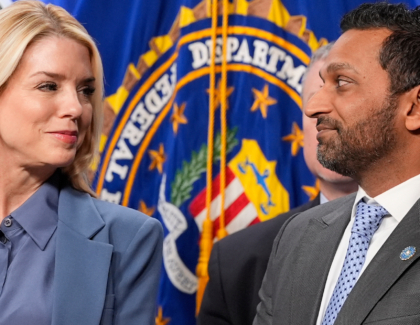Sign up for the daily CJR newsletter.
In a boffo performance that won’t come soon to a theater near you, Nicolas Cage appeared before the Nevada Senate Finance Committee early in May to support a state tax credit for film production in Nevada. The actor, who lives in Las Vegas and won a best actor Oscar for his performance in the 1995 film, Leaving Las Vegas, delivered a handy selection of broadcast- and publication-ready sound bites to a full scrum of news crews that were happy to use them. “I have four scripts that could easily be shot in Nevada,” the Las Vegas Sun quoted him as saying. “I know investors around the world. I could give you names. Give me six months, and I’ll give you a list of names of folks who would love to come to Nevada to make a movie.”
Less than two months later, Gov. Brian Sandoval signed the tax credit bill into law, allowing up to $20 million in annual state tax breaks to be bestowed on qualifying film and television projects, with no one production eligible for more than $6 million in credits.
In many ways, the Nevada tax credit bill followed a script common to such “tax expenditures.” A legislative champion–in this case, Democratic State Sen. Aaron Ford–brought forward a measure to give an industry a tax break, contending that it would encourage the industry to expand in the state and create jobs. A requisite number of public officials and business leaders supported the measure as a good idea, generally speaking. Good-government organizations weighed in with their complicated concerns, and the news media provided standard-issue coverage, quoting supporters and opponents of the measure fairly, but without going deeply into details as to their reasoning. And the bill became law, because in the abstract, almost everyone is almost always in favor of lower taxes and more jobs.
Indeed, Nevada’s film tax credit is anything but exceptional: The Motion Picture Association of America website lists 40 states as having significant tax incentives for film production. Nicolas Cage aside, the process by which this particular tax break became law was fairly routine.
And that, it seems, is the problem.
Shortly after Cage’s appearance at the Nevada legislature, Jon Ralston, a longtime Nevada political journalist, unleashed a torrent of criticism on his blog, including this seething summary: “This is how they do tax policy–a hodgepodge of giveaways and takeaways with no underlying rationale or overarching approach. This is tax policy in Nevada.”
Ralston hosts the Ralston Reports news program, has written for both the Las Vegas Sun and the Review-Journal, and has watched Nevada politics and media for years. In a recent interview, he said he found “all of the fawning tweets and coverage” of Cage to be “utterly ludicrous,” given the state’s low ranking on a number of quality-of-life indices, particularly indices concerning education. He acknowledged that he hasn’t made a thorough survey of media coverage of the film tax credit but also offered a criticism born of long experience: He thinks the state’s major media outlets have done far too little in-depth coverage of a Nevada tax-expenditure problem that extends far beyond the film tax credit, and that showers businesses with tax breaks while it deprives the state of revenue it desperately needs. (As Exhibit A of that problem, Ralston points to $89 million in tax incentives given last year to Apple as an incentive for the company to locate a data storage center outside Reno.)
The Sun and Las Vegas Review-Journal journalists who covered the film tax credit bill acknowledge that Cage’s appearance in the capitol momentarily captivated the media, and that Nevada has a tax expenditure problem. Their view of the coverage of tax expenditures is more nuanced than Ralston’s; where he sees failure, they see effort with limited resources and at least partial success.
Anjeannette Damon, senior editor for politics at the Sun, said the Cage appearance created a “spectacle” within a “circus atmosphere” that Democratic supporters of the tax credit had fostered. As a result, she concedes, the Sun‘s coverage of that appearance was somewhat “light-hearted.” But she said she thought that, overall, the paper covered the film tax credit bill reasonably critically. And even if it didn’t do a deep dive specifically on the bill, she said, Sun reporter Andrew Doughman did write a story earlier in the year that explored the state’s lack of systematic study of tax expenditures. She also cited two lengthier pieces–one detailing some of the hundreds of millions of dollars of tax expenditures passed in the legislature, the other on who would benefit from the film tax measure –as worthy parts of the paper’s coverage of tax breaks.
Las Vegas Review-Journal Capitol Bureau reporter Sean Whaley said he thought the film tax credit bill “got a fair amount of attention,” and that his articles on the bill quoted both supporters and opponents of the bill. The legislature is covered by a lot fewer reporters these days, “for reasons we’re all familiar with,” Whaley said, but, because of Cage’s involvement, the film tax credit bill actually got more attention than other tax expenditures. It was, Whaley said, “fairly well documented for the public.”
That statement, factual though it may be, is not a particularly stirring call to the kind of aggressive journalistic treasury protection that taxpayers deserve.
The film tax credit bill in Nevada did indeed get media attention; drawing media attention is, after all, something Hollywood does well. Given the amount of work to be done in covering a legislature in session, it is also reasonable to claim that daily reportage on the film tax bill was adequate. Coverage of the bill included comments from critics–among them the Nevada Taxpayers Association and the Nevada Policy Research Institute–and over time, the bill changed, apparently in response to criticism. The tax credit measure that passed offers just $20 million (rather than the original $50 million) in tax breaks to film producers, and it became a time-limited pilot program, expiring at the end of 2017 unless there is further legislative action. Also, the legislature passed two bills designed to measure the cost of a variety of tax breaks the state has awarded.
Even so, Nevada’s major journalism outlets need to marshal their resources to do a better job of policing the state’s tendency to deplete the treasury through tax breaks for business. From the largely superficial coverage provided by the Sun and the Review-Journal, readers could have gleaned no real idea as to whether the tax credits being proposed did or did not have a reasonable prospect of luring production facilities and long-term film industry jobs to Nevada. Also, the most thorough and in-depth coverage of the film tax break came after the relevant bill was signed into law, when that coverage could not possibly have helped shape the legislation or action on it. (One of those after-the-fact stories made a startling point: Because most film productions coming to Nevada will owe relatively small amounts of state tax, and Nevada’s film tax credits are transferrable, a significant beneficiary of the film tax credits will actually be casinos, which can acquire the credits from film makers and apply them to gambling tax bills.)
It is time consuming to make a proper journalistic assessment of the merits of a proposed industry tax break meant to spur economic development. Each such proposal has unique and devilish details, and tax incentives aimed at the same economic development goal can vary wildly among states. Capitol reporters cannot reasonably be expected to undertake such deep assessments–to assemble the complex array of facts needed to properly weigh costs and benefits–while they cover a busy legislative session full of important legislation.
But editors know–or certainly should know–that extra resources will be needed to make these kinds of assessments, because in almost every session of almost every legislature, industries will seek tax breaks, asserting that they are needed to create jobs. It is a plot line so predictable that Nevada’s major media should have no difficulty preparing for it to appear once again when the Nevada Legislature next meets.
Follow @USProjectCJR for more posts from this writer and the rest of the United States Project team.
Has America ever needed a media defender more than now? Help us by joining CJR today.






